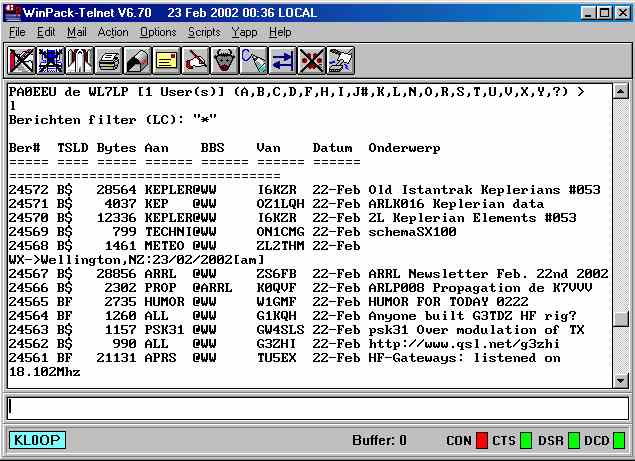
![]()
Packet Radio
Packet Radio has been around since '80. From about 1984 I worked
with Packet Radio for the first time. The only computer I had then was a Commodore
64! With a homebuilt radio interface (TNC - Terminal Node
Controller) plugged in at the rear of the Commodore, a software program of which
I have forgotten the name and a Motorola Metrum transceiver I could work with
Packet Radio quite nicely in the 2 meter band. Apart from the computers and the
TNC. Although an extensive packet radio network including back-bone networks
have been set up the technology has not really changed since then. The speed of
communication was then 1200 Baud and still is. I have a modem for 9600 Baud but
cannot use it for lack of such speeds on the network. The main reason is that
increasing the Baud rate the cost increases rapidly and that is not a popular
subject amongst radio amateurs. Packets of digital information
are sent, together with and 'overhead' with network information such as
the destination and a checksum, over the network. The checksum is checked
in the network and at the receiving end. If the data has been corrupted and thus
the checksum is not right, the packet is rejected and such information is sent
back to the sender, who can then repeat the packet until a 'packet received'
signal is obtained. The network can be a radio network, the internet network or
land lines. Packets can take various routes in the network, if that is allowed
or available.
As other senders are also sending packets such packets can 'collide'. If a no 'packet
received' signal is received, than the sender will repeat the transmission. This
is only a primitive attempt to explain the packet technique. For more
information see the URL's mentioned below. One URL has a series of 18 articles
describing what packet is. The AX.25 protocol was originally developed for
transmission over land lines.
Dutch PTT or KPN nowadays, used the protocol on their Datasets 1 and 2. Radio
amateurs modified the original land line protocol to AX.25A (A stands for
Amateur). In my opinion packet is still useful but not a very sophisticated
mode. The transmission speed of 1200 Baud is rather slow. Furthermore the
protocol was not intended for radio usage; the overhead is big compared to the 'payload'.
Higher transmission speeds are available but are not very popular amongst radio
amateurs due to the much higher costs involved. Apart from the VERON and the ARRL I am also a member and supporter of the
Dutch Packet Working Group Netherlands (PWGN). The PWGN was founded on June 14,
1991. Its purpose, among others, is to maintain and renew the Packet Radio
network and to stimulate the use of digital communication techniques in amateur
radio. As you can see the club's second Lustrum is drawing near now. The PWGN's
web site is set up in both the Dutch and English languages and certainly worth a
visit: http://www.pwgn.nl/
http://www.ui-view.com/winpack/index.shtml
G4IDE/Roger Barker's site, the author of the excellent packet program Winpack.
From this URL you can download the latest version 6.70. Winpack is a very
sophisticated packet program full with features.
An example of Winpack Version 6.70. I am listening to packet BBS PI8VAD on 430.700 MHz and as you can see there is a P(rivate) mail # 44552 for me from MC1UK. The number of characters in this message is 3467. The other numbers are bulletins with all sorts of information. You can download 'Topics' messages automatically. If a Topic is RTTY then Winpack will connect and download all RTTY messages.

In this example I am connected (notice that CON is RED coloured now) via a Telnet connection and the internet to KL0OP/WL7LP in Alaska.
http://www.choisser.com/packet/ --->
By Larry Kenney, WB9LOZ - This series of eighteen articles was originally written in 1988 to appear in Nuts & Volts, the newsletter of the San Francisco Amateur Radio Club. The series has been widely distributed since then, with revisions issued in 1991, 1993, and 1995. Now that the series appears on the Web, it is continuously updated, as needed, at this site.http://www.choisser.com/hamradio/packet.html
http://www.packetradio.com/primer.htm
http://www.g8pzt.pwp.blueyonder.co.uk/fourpak/pktindex.htm
http://members.tripod.com/~g6odt/packet.html Ui-View